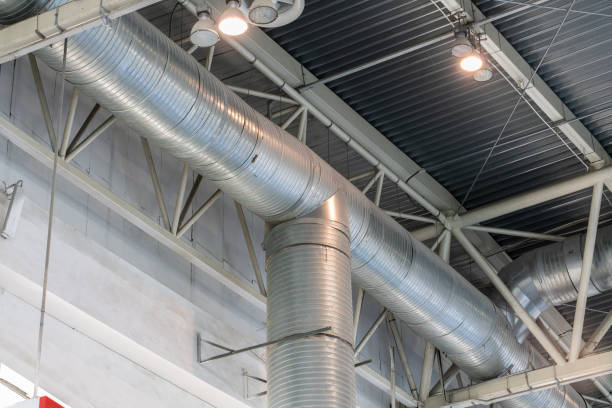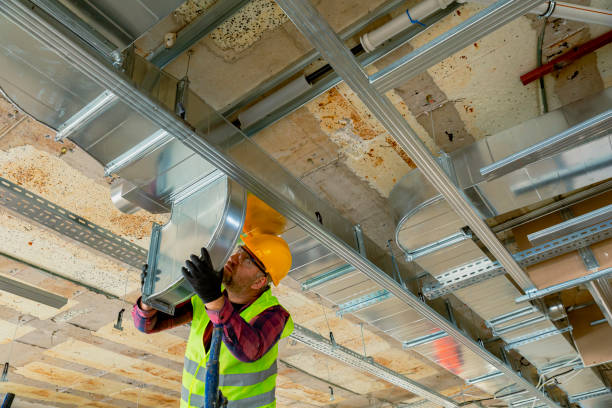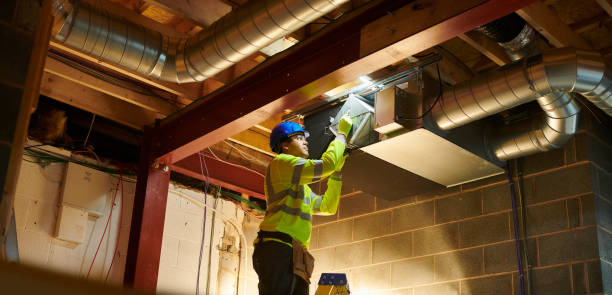The ISO HVAC standards are crucial for any industry. This article covers the international organization for standardization & heating, ventilation, and air conditioning standards, an essential issue. We’ll examine how these requirements ensure system efficiency and safety. Understanding these standards can help you understand heating, ventilation, and air conditioning system design, installation, and maintenance, allowing you to make educated decisions.
Background of ISO HVAC standards
HVAC definition: HVAC is heating, ventilation, and air conditioning. It includes building heating, cooling, and indoor air quality systems and equipment. The standard of everything, from the small HVAC hose to the complete system, is essential to achieving and sustaining function and comfortability.
The value of heating, ventilation and air conditioning standards: These standards govern heating, ventilation, and air conditioning system design, installation, operation, and maintenance. Building owners and heating, ventilation, and air conditioning specialists may maximize energy efficiency, indoor air quality, and thermal comfort by following these requirements.
ISO International Organization for Standardization: The independent, non-governmental International Organization for Standardization creates and publishes standards for quality, safety, and efficiency in numerous sectors. It has developed internationally accepted heating, ventilation, and air conditioning standards, which have advanced the profession.
ISO’s HVAC standards work
Impact of ISO on heating, ventilation and air conditioning standards: Standard development and implementation bring together international experts to create consensus-based standards that represent global best practices. Also, it helps enterprises improve efficiency, sustainability, and regulatory compliance by harmonizing heating, ventilation, and air conditioning practices worldwide.
ISO HVAC standard development: These standards undergo a rigorous procedure to assure quality and impartiality. It starts with a requirement for a new or revised standard. Next, heating, ventilation, and air conditioning engineering, building science, and energy efficiency specialists create working groups. These working groups, or HVAC consultants, design the standard with stakeholder involvement and comprehensive evaluations and consultations.
The standards committees: It maintains special committees for heating, ventilation and air conditioning standard development and maintenance. These committees include technical specialists from member nations who help standardize. ISO/TC 205 Building environment design, ISO/TC 205/SC 2 Ventilation and air conditioning, and ISO/TC 86 Refrigeration and air conditioning are international organizations for standardization & heating, ventilation, and air conditioning standards committees.

Key ISO HVAC standards
ISO 16813:2016—Building environment design—Indoor environment—General concepts
This standard outlines building heating, ventilation, and air conditioning design concepts. It addresses indoor air quality, thermal comfort, and energy efficiency. The 16813:2016 promotes sustainable and comfortable indoor spaces by addressing the building’s environment and occupant demands when designing ventilation and air conditioning systems.
ISO 7730:2005—Ergonomics of the thermal environment—Compute PMV and PPD indices and local thermal comfort parameters to analyze and interpret thermal comfort
The 7730:2005 measures interior thermal comfort. It evaluates the thermal environment using PMV and PPD indices. Air conditioning specialists may design systems that optimize thermal conditions for occupant comfort and productivity using this standard.
ISO 11855: Building district heating and cooling
Several elements of 11855 cover building district heating and cooling systems. These standards address pipe design, heat transfer stations, and controls. The 11855 supports effective and dependable heating and cooling services for numerous buildings, decreasing energy use and environmental impact.
ISO 15927: Building energy performance—Heating energy calculation
The 15927 calculates building heating energy. It standardized heating system energy performance and building energy consumption evaluation. The 15927 helps building owners and ventilation and air conditioning specialists evaluate heating system efficiency and find ways to enhance it.
Implementing ISO HVAC standards benefits
Improved energy efficiency: These standards improve building energy efficiency. These guidelines promote energy-efficient ventilation and air conditioning system design and operation. Energy waste reduction lowers carbon footprints and operational expenses.
Enhanced indoor air quality: Also, these standards promote indoor air quality to keep occupants healthy and comfortable. These guidelines regulate ventilation, pollution management, and filtration to purify the air. Health, well-being, and productivity can improve with better indoor air quality.
Improved thermal comfort: Further these standards emphasize thermal comfort, or occupant satisfaction with building thermal conditions. Ventilation and air conditioning specialists may design and run systems with optimal temperature, humidity, and airflow by following these criteria. Improved thermal comfort boosts productivity and enjoyment.
Lower environmental impact: These standards reduce environmental effect in several ways. These regulations reduce greenhouse gas emissions from heating and cooling by boosting energy efficiency. Indoor air quality guidelines reduce environmental pollution. They help enterprises achieve environmental goals.
Global consistency, compatibility: Global uniformity and compatibility are major benefits of international organization for standardization & heating, ventilation, and air conditioning standards. These worldwide standards provide a foundation for ventilation practitioners, manufacturers, and regulators. Global consistency aligns technical requirements and best practices across countries, enabling air conditioning commerce and collaboration.
HVAC ISO standards and energy efficiency
Building environment design—ISO 16813:2016
Heating, ventilation, and air conditioning energy efficiency is considered in 16813:2016’s building environment and energy performance. It stresses the significance of combining ventilation design with insulation, fenestration, and renewable energy systems. It reduces energy use and greenhouse gas emissions by optimizing building energy performance.
ISO 13790: Building energy performance—Calculating space heating and cooling energy usage
The 13790 calculates building air conditioning energy utilization. It considers the building’s thermal qualities, climate, and occupancy. It helps building owners and designers evaluate energy efficiency and find energy savings.
ISO 52016: Building energy performance—Heating and cooling demands
52016 determines building heating and cooling energy demands. It gives energy demand calculations based on climate, building envelope, and design parameters. It aids ventilation designers and energy assessors in estimating heating and cooling needs for energy-efficient air conditioning systems.

ISO HVAC indoor air quality standards
ISO 7730:2005—Thermal ergonomics
The 7730:2005 evaluates indoor air quality and thermal comfort. It helps assess air velocity, humidity, and quality, which affect occupant comfort and well-being. Heat and ventilation designers may create clean, pleasant indoor air systems by addressing these criteria.
ISO 16000: Indoor air quality
The 16000 covers indoor air quality measurement and control in many standards. Measure and analyze pollutants, including VOCs and particulate matter, using these criteria. It ensures occupant health by maintaining clean, pollutant-free indoor environments.
ISO 14644: Cleanrooms and regulated environments
The 14644 series covers cleanrooms, which strictly regulate airborne particles and other pollutants. These standards govern cleanroom categorization, design, operation, and monitoring. Pharmaceuticals, electronics, and healthcare can maintain sterility in regulated conditions by following 14644.
ISO district heating and cooling system standards
ISO 11855-1: General
The 11855-1 outlines district heating and cooling system ideas and principles. It includes system components, heat sources, and distribution. District heating and cooling stakeholders can efficiently and reliably distribute thermal energy to many buildings by adopting 11855-1.
ISO 11855-2: District heating pipes
The 11855-2 addresses district heating pipes, which are essential to district heating systems. This standard specifies pipe materials, dimensions, and installation. Designers and installers may assure district heating pipe performance, durability, and safety by following 11855-2.
ISO 11855-3: District cooling pipes
The 11855-3 discusses district cooling pipes, which transport chilled water to many buildings. This standard specifies district cooling pipe materials, dimensions, and installation procedures. It helps district cooling stakeholders guarantee system efficiency and reliability.
ISO 11855-4: Pipe parts
11855-4 covers district heating and cooling pipe components such valves, pumps, and heat exchangers. This standard ensures these components’ compatibility, performance, and safety in the district heating or cooling system. It helps stakeholders design and run district heating and cooling systems.
ISO HVAC energy calculations standards
ISO 15927: Building energy performance—Heating energy calculation
As noted in the Key ISO HVAC Standards section, 15927 calculates building heating energy usage. It considers climate, heating systems, and building attributes. This helps energy assessors and designers estimate heating energy needs and optimize building energy efficiency.
ISO 13790: Space heating and cooling energy calculation
As indicated, 13790 provides a thorough approach for estimating heating, ventilation, and energy usage for space heating and cooling. It takes into account weather, building envelope, and system efficiency. This helps energy assessors and designers reliably evaluate ventilation energy performance and efficiency.
ISO 52016: Heating and cooling energy demands
The 52016, which emphasizes energy efficiency, also calculates heating and cooling energy consumption. It gives energy demand calculations based on climate, building envelope, and system efficiency. It helps companies estimate their energy needs and optimize their energy performance.
ISO 16358: Building energy performance—Design, construction, and operation of demand response systems
16358 covers building demand response system design, construction, and operation. Demand response adjusts energy usage to supply and demand patterns for grid stability and efficiency. Building owners and energy managers may improve ventilation systems, minimize energy expenditures, and help stabilize the electricity grid by applying 16358.
Heating technologies and ISO HVAC standards
ISO 16813:2016—Building heating systems—Calculation of energy needs and efficiency
In addition to building environment design, 16813:2016 covers heating systems. It calculates the building heating system’s energy requirements and efficiency. Air conditioning specialists may correctly measure heating system performance and efficiency using 16813, enabling energy-efficient design and operation.
ISO 9241: Human-system ergonomics
The 9241 addresses ergonomics and human-system interaction. It advises on usability and satisfaction-promoting systems, interfaces, and user interaction design. Users may quickly and successfully interact with heating, ventilation, and air conditioning systems using 9241 user interfaces and controls.
ISO 5167: Fluid flow measurement
The 5167 measures fluid flow, which is used in air conditioning. It covers pipe fluid flow rate measurement using various flow meters. Ventilation specialists can accurately measure fluid flow and optimize heating and cooling systems by following 5167.
Conclusion
ISO HVAC standards help buildings improve energy efficiency, indoor air quality, and thermal comfort. They assist companies in creating sustainable and comfortable interior environments by providing heating, ventilation, and air conditioning system design, installation, operation, and maintenance standards. By utilizing international organizations for standardization & heating, ventilation, and air conditioning standards, stakeholders may increase energy efficiency, indoor air quality, environmental impact, and heating, ventilation, and air conditioning industry global uniformity and compatibility.



